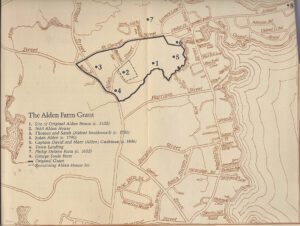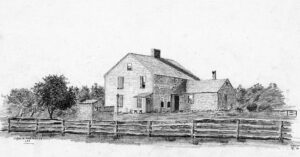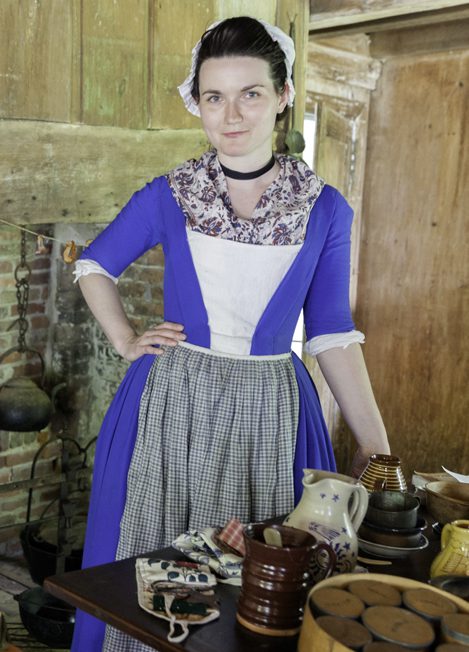Explore
Alden First Site History
The Alden family spent the initial years of their life in the New World living at Plymouth Plantation. They were assigned a house lot at the westerly end of the first street (now Town Square) where School Street is today in 1623 and several acres of farmland beyond what is now North Street. The original 1620 agreement between the colonists and the investors had stipulated that such a division would be made seven years after the Mayflower voyage. In May 1627, they divided the colony’s livestock into 12 lots of one milch cow and two she-goats each. Each lot was shared among 13 people—men, women and children.
 The following January (1627/28), every individual was allotted a share of 20 acres of land, creating family farms capable of maintaining the population. These allotments were located along the shore of the harbor from Eel River on the south to Powder Point at the north. The Aldens received about 100 acres in this division; 20 acres each to John, Priscilla, Elizabeth and John, Jr., with an additional share perhaps for Joseph who was born about 1627. The location of the 1627/28 grants was made by drawing lots, after which the area was surveyed to account for the appropriate number of acres. We assume that John prepared the land for planting and began work on their new house in the spring of 1628, and that by 1629 or 1630 they were in seasonal residence on Blue Fish River and Houndsditch brook.
The following January (1627/28), every individual was allotted a share of 20 acres of land, creating family farms capable of maintaining the population. These allotments were located along the shore of the harbor from Eel River on the south to Powder Point at the north. The Aldens received about 100 acres in this division; 20 acres each to John, Priscilla, Elizabeth and John, Jr., with an additional share perhaps for Joseph who was born about 1627. The location of the 1627/28 grants was made by drawing lots, after which the area was surveyed to account for the appropriate number of acres. We assume that John prepared the land for planting and began work on their new house in the spring of 1628, and that by 1629 or 1630 they were in seasonal residence on Blue Fish River and Houndsditch brook.
John and Priscilla Alden’s second home (after the house in Plymouth) was located about 760 feet southeast of the Alden House Historic Site. The site was first professionally excavated and documented by historical archaeologist Roland Wells Robbins in 1960. Robbins’ investigation revealed that this early house had a foundation that measured about 10 ½ by 38 feet; with a cellar hole about 6 ½ feet square and 7 ½ feet deep at the westerly end. Many bricks and fragments of brick, which presumably made up the chimney, were found scattered throughout the excavation but no indication of a chimney base was found. There was a small depression in about the middle of the foundation that may have been the location of the hearth. For more information on the Alden First Site click here
Explore the world of John and Priscilla Alden and 17th century Duxbury through recent research about the archaeology artifacts unearthed from the Alden First Site.
Alden House Historic Site History
The Alden House Historic Site (AHHS), and the property upon which it rests, are part of the original land grant given to John and Priscilla Alden in 1627. Designated a National Historic Landmark in 2009, the house is an important piece of American history that provides visitors will an intimate look at one of Americas founding families. The core of the present house was built circa 1700 by Jonathan Alden, probably before the death of his father John, perhaps around the time of his marriage in 1672.
 Over the next three centuries the Alden family would occupy and in time preserve the home so that future generations can engage with the story of one of America’s founding families. Today, the Alden House, with its two and a half acres of land, has the distinction of being the unique instance of still belonging to the same family to which it was originally issued in the land division of 1627. The house has been operated as a museum by the Alden Kindred since 1960, and continues to welcome visitors from across the globe. For more information on the Alden House Historic Site click here
Over the next three centuries the Alden family would occupy and in time preserve the home so that future generations can engage with the story of one of America’s founding families. Today, the Alden House, with its two and a half acres of land, has the distinction of being the unique instance of still belonging to the same family to which it was originally issued in the land division of 1627. The house has been operated as a museum by the Alden Kindred since 1960, and continues to welcome visitors from across the globe. For more information on the Alden House Historic Site click here
Alden Kindred History
The increasing interest in colonial history and genealogy in the 1890s that lead to the establishment of the Mayflower Descendant societies also inspired the founding of the Alden Kindred. Miss A. Ella Alden of Middleboro, Mass. conducted a correspondence campaign with as many Aldens as she could identify, urging them to attend a family reunion on September 11, 1901. About 150 people were at that first gathering in Highland Park in Avon, Massachusetts, when the decision was made to create a permanent organization, the Alden Kindred of America. The second reunion in 1902 was at the Alden house in Duxbury at the invitation of John W. Alden. In 1905, the Alden Kindred began a discussion about acquiring the property, which now consisted of about 2.7 acres. Nothing changed after the Kindred purchased the house in 1907, and John W. and Sylvia Alden continued to live there until 1920.
In 1921, Charles L. Alden, treasurer and founding member of the Alden Kindred was given a twenty-year lease on the house to continue improvements and manage it, at one dollar a year. He guaranteed that “the members of the Alden Kindred of America, Inc., individually or collectively shall have the right of entrance or assembly upon said premises at any time without charge or cost.”
 Over the following few decades Mr. Alden spent a considerable amount of his own money on the property. He refurbished the rooms and installed antiques from his own collection alongside the few pieces owned by the Kindred. Charles renewed his lease for another 20 years in 1938, and his family continued to manage the museum after his death in 1943. This arrangement continued until the mid-1950s, when new officers in the Alden Kindred decided take on the management of the home.
Over the following few decades Mr. Alden spent a considerable amount of his own money on the property. He refurbished the rooms and installed antiques from his own collection alongside the few pieces owned by the Kindred. Charles renewed his lease for another 20 years in 1938, and his family continued to manage the museum after his death in 1943. This arrangement continued until the mid-1950s, when new officers in the Alden Kindred decided take on the management of the home.
The Alden Kindred then took direct charge for the first time, and applied for tax-exempt status for the house, which they received in 1956. During the 1960s and 1970s, the Alden House settled into a comfortable routine as an historic house museum and location of the Alden Kindred of America’s annual meeting. Repairs and maintenance became routine, and the pace of artifact acquisition slowed to a trickle. However, the volunteers who kept the house going recognized that the existing state of affairs could not continue without some important changes.
With numerous buildings in need of repair, the Alden Kindred began work on the design of a new building.The intent was to have the new support structure resemble a barn to indicate the property’s long agricultural history. The Kindred decided to build a barn-like support structure where an old “wood shed” (not the one attached to the house) or barn had stood on the slope northeast of the house. Groundbreaking for the Barn took place on 18 October 1997. The building was impressively constructed in a traditional timber frame manner that enhanced the interior barn motif. The frame was raised on 18 April 1998, and the building was ready for occupancy the following year.
Just as the Alden Kindred was born out of the turn of the previous century, the 21st century brought a renewed desire to celebrate and preserve our heritage. Although a routine commemoration might have acknowledged the 100th anniversary of the first meeting in 1901, the excitement surrounding the turn of the Millennium resulted in the observation of the 100th actual meeting in August 2000 as a major event. Over a five-day period, more than 340 Alden descendants descended on the old homestead. For more information on the Alden Kindred of America click here



